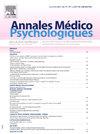Comparative analysis of the identification efficacy of the bipolarity index and diagnostic and statistical manual of mental disorders, 5th edition, for bipolar disorder screening among college students
IF 0.5
4区 医学
Q4 PSYCHIATRY
引用次数: 0
Abstract
Objective
This study aims to explore the differences in the identification efficacy of the Bipolarity Index (BPX) and the Diagnostic and Statistical Manual of Mental Disorders, 5th Edition (DSM-5), as screening approaches for bipolar disorder (BD).
Methods
A total of 150 college students with depressive episodes who underwent outpatient and inpatient treatment at Central China Normal University Hospital and the Renmin Hospital of Wuhan University between January 2021 and December 2022 were selected as research participants. We used a self-developed general data questionnaire to collect comprehensive demographic and clinical data from all participants. This questionnaire covered various aspects including gender, age, occupation, education level, drinking habits, age at onset, disease duration, frequency and duration of the current episode, comorbidities, family history of genetic conditions, diagnosis and prognosis. Participants were evaluated using the BPX, the DSM-5 and the International Classification of Diseases, 10th Revision (ICD-10). Clinical diagnosis based on the ICD-10 served as the standard against which the BPX and DSM-5 were compared for sensitivity, specificity, accuracy, positive predictive value (PPV) and negative predictive value (NPV). Additionally, we conducted a multivariate logistic regression analysis to evaluate risk factors associated with BD.
Results
The sensitivity, specificity, accuracy, PPV and NPV were 85.34%, 81.90%, 84.00%, 87.21% and 79.69% for the BPX screening, and 72.73%, 90.32%, 80.00%, 91.43% and 70.00% for the DSM-5 screening, respectively. The study also identified significant clinical characteristics that differentiated those who screened positive for BD using the BPX. These characteristics included a younger average age at onset, a higher prevalence of atypical depression and more frequent prior affective episodes compared with those who did not meet the BPX criteria for BD. Risk factors associated with BD included atypical depression, history of suicide attempts, four or more previous affective episodes, borderline personality disorder, mixed states and a family history of BD.
Conclusion
In conclusion, our findings suggest that the BPX exhibits superior sensitivity in screening for BD among college students compared with the DSM-5. Additionally, the study identifies significant risk factors (e.g., atypical depression, history of suicide attempts and multiple previous affective episodes), which are crucial for early detection and management.
双相情感障碍指数与第5版《精神障碍诊断与统计手册》在大学生双相情感障碍筛查中的识别效果比较分析
目的探讨双相情感障碍指数(BPX)与《精神障碍诊断与统计手册》第5版(DSM-5)作为双相情感障碍(BD)筛查方法的鉴别效果差异。方法选取2021年1月至2022年12月在华中师范大学附属医院和武汉大学附属人民医院门诊和住院治疗的大学生抑郁发作患者150名作为研究对象。我们使用自行开发的一般数据问卷来收集所有参与者的综合人口统计学和临床数据。问卷内容包括性别、年龄、职业、受教育程度、饮酒习惯、发病年龄、病程、当前发病频率和持续时间、合并症、遗传病家族史、诊断和预后。使用BPX、DSM-5和国际疾病分类第十版(ICD-10)对参与者进行评估。以ICD-10作为临床诊断标准,比较BPX和DSM-5的敏感性、特异性、准确性、阳性预测值(PPV)和阴性预测值(NPV)。结果BPX筛查的敏感性、特异性、准确性、PPV和NPV分别为85.34%、81.90%、84.00%、87.21%和79.69%,DSM-5筛查的PPV和NPV分别为72.73%、90.32%、80.00%、91.43%和70.00%。该研究还发现了重要的临床特征,这些特征可以区分使用BPX筛查的双相障碍阳性患者。这些特征包括平均发病年龄较低、非典型抑郁患病率较高、既往情感发作频率较高。与非典型抑郁、自杀未遂史、4次及以上既往情感发作、边缘型人格障碍、混合状态和BD家族史相关的危险因素。我们的研究结果表明,与DSM-5相比,BPX在筛查大学生双相障碍方面表现出更高的敏感性。此外,该研究确定了重要的风险因素(例如,非典型抑郁症,自杀未遂史和多次以前的情感发作),这对早期发现和管理至关重要。
本文章由计算机程序翻译,如有差异,请以英文原文为准。
求助全文
约1分钟内获得全文
求助全文
来源期刊

Annales medico-psychologiques
医学-精神病学
CiteScore
1.30
自引率
33.30%
发文量
196
审稿时长
4-8 weeks
期刊介绍:
The Annales Médico-Psychologiques is a peer-reviewed medical journal covering the field of psychiatry. Articles are published in French or in English. The journal was established in 1843 and is published by Elsevier on behalf of the Société Médico-Psychologique.
The journal publishes 10 times a year original articles covering biological, genetic, psychological, forensic and cultural issues relevant to the diagnosis and treatment of mental illness, as well as peer reviewed articles that have been presented and discussed during meetings of the Société Médico-Psychologique.To report on the major currents of thought of contemporary psychiatry, and to publish clinical and biological research of international standard, these are the aims of the Annales Médico-Psychologiques.
 求助内容:
求助内容: 应助结果提醒方式:
应助结果提醒方式:


